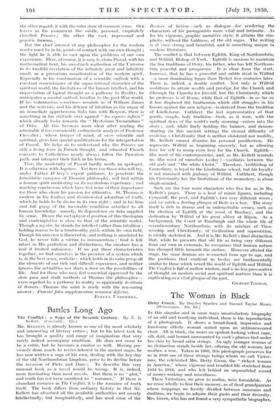The Woman in Black
Hetty Green. By Boyden Sparkos and Samuel Taylor Moore. (Heinemann. 10s. 6d.) Ix this singular and in sonic ways unsatisfactory biography of an odd and terrifying individual, there is the reproduction of a photograph. It shows a broad-faoed, impressive and handsome elderly woman seated upon an antimacassared chair. All in black, she wears an opulent-looking velvet cape, silk skirt, and bonnet surmounted by cock's plumes tied under her chin by broad satin strings. An ugly younger woman of no distinction stands_beside her, offering the old woman, her mother, a rose. Taken in 1908, this photograph preserves for us in 1930 one of those strange beings whom we call Victor- ians, the celebrated Mrs. Iletty Green, the " richest woman in America," whose vigorous and troubled life stretched from 1834 to 1916, and who left behind an unparalleled record of money-making and miserliness.
These Victorians, we grow to realize, were formidable. As we cease wholly to fear their memory, as of dead grandparents whose trappings we hastily divided between museums and dustbins,, we, begin to admire their gusto and their diversity. Mrs. Green, who has not found a very sympathetic biographer,
rises up out of the past impressively. No one was ever mote tirelessly devoted herself to one end. She was the stuff of which reformers and pioneers are made—but with a difference.
Born the heiress to Quaker fortunes, made in the New Bedford whaling industry, daughter of a money-loving father and of a slatternly and invalid mother, Hetty was often set to read the financial news to her grandfather, often tagged at her father's heels about the waterfront. In him she had a first-rate example of tight-fistedness. He encouraged her untidiness. At the age of eight she began to save money. At sixteen, she already had a business head. At nineteen, she invested in bonds the money given her for clothes she needed during a season in New York society. From twenty to thirty she conducted a long and horrifying campaign designed to secure absolutely her invalid aunt's large fortune. Skirmishes with servants, wills written under her compulsion, hysterics, locked boxes abound in this dreadful part of her story in which she seems to have betrayed tendencies verging on the criminal. When she married at thirty-two a man whom she did not love who possessed a million dollars, she had inherited a million from her father and the life-interest in another million under the aunt's will, which she contested in a forceful and apparently unscrupulous way.
Marriage and motherhood tamed her furies but did not abate her hunger for wealth. In one year in London she made another million and a-half dollars. Of her subsequent acquisi- tions and incredible vagaries and meannesses the book speaks at length. Her story is impossible to lay down, for although it would provide material for a magnificent novel, it is sprinkled with facts that would seem audacious and unlikely inventions were they fiction.
She boasted that she ruined her husband because he, as her manager, disobeyed her. She broke a bunk. Financial crises left her richer than ever, for she always had enough money to buy at the bottom of the market, and her instinct in these matters was uncanny. Trudging about Wall Street with securities and deeds crackling in the immense pockets of petticoats under her rusty black skirt, she terrified the financiers who credited her with even more astute operations than she conducted.
Now and then in the story, the " witch of Wall Street " dis- appears. Years before the unkempt girl had on occasion adorned her lovely person with white lawn and crowned her hair with gardenias for a coming-out ball, or in New York had danced not once but twice with Edward VII, then Prince of Wales ; so now, in 1912, the ragged old hag she usually was gave way at a smart reception to a magnificent old lady in white satin, white chiffon, a pendant of " diamond.s the size of peas," and a lorgnette hanging from a rope of rubies and pearls. Also, she was the soul of goodness when it did not mean opening her purse, would nurse the sick or labour incessantly for days to get work for some forlorn old man.
Few characters are hated more than misers, and Mrs. Green's story suggests that few suffer more. Her later life was all terrors, hatred and suspicion. She came to believe that all her relatives had been poisoned, that she was malig- nantly pursued. She carried a revolver. Then the newspapers would never leave her alone, for ever printing droll stories of her absurd appearance, niggardly habits and ridiculous con- versation. From these, however, she perhaps derived a wry pleasure : they emphasized that she was a notable person, that she had power and money. It was upon these things that her strange and cursed heart was set. She died worth almost a hundred million dollars.

















































 Previous page
Previous page